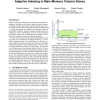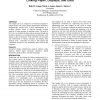816 search results - page 83 / 164 » Interconnect design methods for memory design |
PVLDB
2011
12 years 11 months ago
2011
Adaptive indexing is characterized by the partial creation and refinement of the index as side effects of query execution. Dynamic or shifting workloads may benefit from prelimi...
CHI
1998
ACM
14 years 1 months ago
1998
ACM
The Insight Lab is an immersive environment designed to support teams who create design requirements documents. Requirements emerge from a deep understanding of a problem domain, ...
ASPDAC
2004
ACM
14 years 2 months ago
2004
ACM
As the process technology advances into the deep submicron era, interconnect plays a dominant role in determining circuit performance and signal integrity. Buffer insertion is one...
CODES
2008
IEEE
14 years 3 months ago
2008
IEEE
The combination of flit-buffer flow control methods and latency-insensitive protocols is an effective solution for networks-on-chip (NoC). Since they both rely on backpressure...
CIKM
2008
Springer
13 years 11 months ago
2008
Springer
Statistical machine learning techniques for data classification usually assume that all entities are i.i.d. (independent and identically distributed). However, real-world entities...


